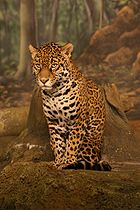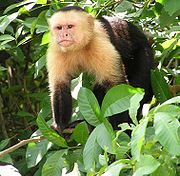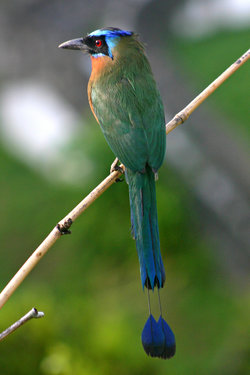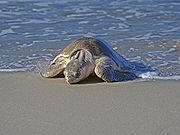
Wildlife of Nicaragua
Encyclopedia

Biodiversity
Biodiversity is the degree of variation of life forms within a given ecosystem, biome, or an entire planet. Biodiversity is a measure of the health of ecosystems. Biodiversity is in part a function of climate. In terrestrial habitats, tropical regions are typically rich whereas polar regions...
. Much of Nicaragua
Nicaragua
Nicaragua is the largest country in the Central American American isthmus, bordered by Honduras to the north and Costa Rica to the south. The country is situated between 11 and 14 degrees north of the Equator in the Northern Hemisphere, which places it entirely within the tropics. The Pacific Ocean...
's wildlife lives in protected areas. There are currently 78 protected areas in Nicaragua, covering more than 22000 square kilometres (8,494.2 sq mi), or about 17% of its landmass. These protected areas encompass a wide variety of habitat
Habitat
* Habitat , a place where a species lives and grows*Human habitat, a place where humans live, work or play** Space habitat, a space station intended as a permanent settlement...
s, including rainforest
Rainforest
Rainforests are forests characterized by high rainfall, with definitions based on a minimum normal annual rainfall of 1750-2000 mm...
s, lakes, mountains, and volcanoes throughout the country. For example, Bosawás Biosphere Reserve
Bosawás Biosphere Reserve
The Bosawás Biosphere Reserve in the northern part of Nicaragua is a hilly tropical forest designated in 1997 as a UNESCO biosphere reserve. At approximately 20,000 km² in size, the reserve The Bosawás Biosphere Reserve in the northern part of Nicaragua is a hilly tropical forest designated...
covers 7300 square kilometres (2,818.5 sq mi), making it the second largest rainforest in the Americas
Americas
The Americas, or America , are lands in the Western hemisphere, also known as the New World. In English, the plural form the Americas is often used to refer to the landmasses of North America and South America with their associated islands and regions, while the singular form America is primarily...
after the Amazon Rainforest
Amazon Rainforest
The Amazon Rainforest , also known in English as Amazonia or the Amazon Jungle, is a moist broadleaf forest that covers most of the Amazon Basin of South America...
in Brazil
Brazil
Brazil , officially the Federative Republic of Brazil , is the largest country in South America. It is the world's fifth largest country, both by geographical area and by population with over 192 million people...
.
Mammals

New World monkey
New World monkeys are the five families of primates that are found in Central and South America: Callitrichidae, Cebidae, Aotidae, Pitheciidae, and Atelidae. The five families are ranked together as the Platyrrhini parvorder and the Ceboidea superfamily, which are essentially synonymous since...
s, including the Geoffroy's Spider Monkey
Geoffroy's Spider Monkey
Geoffroy's spider monkey, Ateles geoffroyi, also known as black-handed spider monkey, is a species of spider monkey, a type of New World monkey, from Central America, parts of Mexico and possibly a small portion of Colombia. There are at least five subspecies. Some primatologists classify the...
, which is currently listed by the International Union for Conservation of Nature (IUCN) as an endangered species
Endangered species
An endangered species is a population of organisms which is at risk of becoming extinct because it is either few in numbers, or threatened by changing environmental or predation parameters...
. The jaguar
Jaguar
The jaguar is a big cat, a feline in the Panthera genus, and is the only Panthera species found in the Americas. The jaguar is the third-largest feline after the tiger and the lion, and the largest in the Western Hemisphere. The jaguar's present range extends from Southern United States and Mexico...
is the largest felid
Felidae
Felidae is the biological family of the cats; a member of this family is called a felid. Felids are the strictest carnivores of the thirteen terrestrial families in the order Carnivora, although the three families of marine mammals comprising the superfamily pinnipedia are as carnivorous as the...
that is indigenous
Indigenous (ecology)
In biogeography, a species is defined as native to a given region or ecosystem if its presence in that region is the result of only natural processes, with no human intervention. Every natural organism has its own natural range of distribution in which it is regarded as native...
to Nicaragua. Other species include the cougar, jaguarundi
Jaguarundi
The jaguarundi is a small-sized wild cat native to Central and South America. In 2002, the IUCN classified the jaguarundi as Least Concern as it is likely that no conservation units, with the probable exception of the mega-reserves of the Amazon basin could sustain long-term viable populations. It...
, margay
Margay
The Margay is a spotted cat native to Middle and South America. Named for Prince Maximilian of Wied-Neuwied, it is a solitary and nocturnal animal that prefers remote sections of the rainforest. Although it was once believed to be vulnerable to extinction, the IUCN now lists it as "Near Threatened"...
, and ocelot
Ocelot
The ocelot , pronounced /ˈɒsəˌlɒt/, also known as the dwarf leopard or McKenney's wildcat is a wild cat distributed over South and Central America and Mexico, but has been reported as far north as Texas and in Trinidad, in the Caribbean...
. There are a number of unusual mammals found in Nicaragua, including the three-toed sloth
Three-toed sloth
The three-toed sloths are tree-living mammals from South and Central America. They are the only members of the genus Bradypus and the family Bradypodidae. There are four living species of three-toed sloths...
, northern tamandua
Northern Tamandua
The northern tamandua is a species of tamandua, a small anteater in the family Myrmecophagidae. They live in tropical and subtropical forests from southern Mexico, through Central America, and to the edge of the northern Andes....
(lesser anteater), and two species of armadillo
Armadillo
Armadillos are New World placental mammals, known for having a leathery armor shell. Dasypodidae is the only surviving family in the order Cingulata, part of the superorder Xenarthra along with the anteaters and sloths. The word armadillo is Spanish for "little armored one"...
.
Birds

Golden-cheeked Warbler
The Golden-cheeked Warbler Dendroica chrysoparia is an endangered species of bird that breeds in Central Texas, from Palo Pinto County southwestward along the eastern and southern edge of the Edwards Plateau to Kinney County...
(Dendroica chrysoparia) and the Great Green Macaw
Great Green Macaw
The Great Green Macaw, Ara ambiguus, also known as Buffon's Macaw or the Great Military Macaw, is a Central and South American parrot found in Nicaragua, Honduras, Costa Rica, Panama, Colombia and Ecuador. Two allopatric subspecies are recognized, the nominate subspecies is found in Central America...
(Ara ambigua), are currently listed by the IUCN as threatened species
Threatened species
Threatened species are any speciesg animals, plants, fungi, etc.) which are vulnerable to endangerment in the near future.The World Conservation Union is the foremost authority on threatened species, and treats threatened species not as a single category, but as a group of three categories,...
. Many of Nicaragua's birds are brilliantly colored, including various species of parrots
True parrots
The true parrots are about 330 species of bird belonging to the Psittacidae family, one of the two "traditional" families in the biological order Psittaciformes . The other family is the Cacatuidae which are also parrots, but not classified as true parrots...
, motmot
Motmot
The motmots or Momotidae are a family of birds in the near passerine order Coraciiformes, which also includes the kingfishers, bee-eaters and rollers. All extant motmots are restricted to woodland or forest in the Neotropics, and the largest diversity is in Middle America. They have a colourful...
s, toucan
Toucan
Toucans are members of the family Ramphastidae of near passerine birds from the Neotropics. The family is most closely related to the American barbets. They are brightly marked and have large, often colorful bills. The family includes five genera and about forty different species...
s, trogon
Trogon
The trogons and quetzals are birds in the order Trogoniformes which contains only one family, the Trogonidae. The family contains 39 species in eight genera. The fossil record of the trogons dates back 49 million years to the mid-Eocene. They might constitute a member of the basal radiation of...
s, and hummingbird
Hummingbird
Hummingbirds are birds that comprise the family Trochilidae. They are among the smallest of birds, most species measuring in the 7.5–13 cm range. Indeed, the smallest extant bird species is a hummingbird, the 5-cm Bee Hummingbird. They can hover in mid-air by rapidly flapping their wings...
s. The guardabarranco
Turquoise-browed Motmot
The Turquoise-browed Motmot also called Torogoz by the inhabitants of El Salvador and Guardabarranco in Nicaragua; is a colourful, medium-sized bird of the motmot family, Momotidae. It inhabits Central America from south-east Mexico , to Costa Rica, where it is common and not considered threatened...
is the national bird of Nicaragua.
Reptiles

Sea turtle
Sea turtles are marine reptiles that inhabit all of the world's oceans except the Arctic.-Distribution:...
s, including the hawksbill sea turtle, leatherback sea turtle
Leatherback Sea Turtle
The leatherback sea turtle is the largest of all living sea turtles and the fourth largest modern reptile behind three crocodilians. It is the only living species in the genus Dermochelys. It can easily be differentiated from other modern sea turtles by its lack of a bony shell. Instead, its...
, loggerhead sea turtle
Loggerhead sea turtle
The loggerhead sea turtle , or loggerhead, is an oceanic turtle distributed throughout the world. It is a marine reptile, belonging to the family Cheloniidae. The average loggerhead measures around long when fully grown, although larger specimens of up to have been discovered...
, olive ridley sea turtle, and the Pacific green turtle (Chelonia mydas agassisi). All of these are endangered or critically endangered
Critically Endangered
Critically Endangered is the highest risk category assigned by the IUCN Red List for wild species. Critically Endangered means that a species' numbers have decreased, or will decrease, by 80% within three generations....
species, with declining global populations. Extensive efforts are currently underway to preserve them as much as possible.
Fishes
The bull sharkBull shark
The bull shark, Carcharhinus leucas, also known as Zambezi shark or unofficially known as Zambi in Africa and Nicaragua shark in Nicaragua, is a shark common worldwide in warm, shallow waters along coasts and in rivers...
is a species of shark that can survive for an extended period of time in fresh water. It can be found in Lake Nicaragua
Lake Nicaragua
Lake Nicaragua or Cocibolca or Granada or is a vast freshwater lake in Nicaragua of tectonic origin. With an area of , it is the largest lake in Central America, the 19th largest lake in the world and the 9th largest in the Americas. It is slightly smaller than Lake Titicaca. With an elevation...
and the San Juan River
San Juan River (Nicaragua)
The San Juan River , also known as El Desaguadero , is a 192.06 km river that flows east out of Lake Nicaragua into the Caribbean Sea. A large section of the border between Nicaragua and Costa Rica runs on the right bank of the river...
, where it is often referred to as the "Nicaragua shark". Nicaragua has recently banned freshwater fishing of the Nicaragua shark and the sawfish
Sawfish
Sawfish, also known as the Carpenter Shark, are a family of rays, characterized by a long, toothy nose extension snout. Several species can grow to approximately . The family as a whole is largely unknown and little studied...
in response to the declining populations of these animals.
Molluscs
Many species of molluscsMollusca
The Mollusca , common name molluscs or mollusksSpelled mollusks in the USA, see reasons given in Rosenberg's ; for the spelling mollusc see the reasons given by , is a large phylum of invertebrate animals. There are around 85,000 recognized extant species of molluscs. Mollusca is the largest...
are indigenous to Nicaragua, including at least 79 species of terrestrial snails and slugs
Gastropoda
The Gastropoda or gastropods, more commonly known as snails and slugs, are a large taxonomic class within the phylum Mollusca. The class Gastropoda includes snails and slugs of all kinds and all sizes from microscopic to quite large...
.
Protected areas
There are currently 78 protected areas in Nicaragua, covering more than 22000 square kilometres (8,494.2 sq mi), or about 17% of its landmass. These include wildlife refugeWildlife refuge
A wildlife refuge, also called a wildlife sanctuary, may be a naturally occurring sanctuary, such as an island, that provides protection for species from hunting, predation or competition, or it may refer to a protected area, a geographic territory within which wildlife is protected...
s and nature reserve
Nature reserve
A nature reserve is a protected area of importance for wildlife, flora, fauna or features of geological or other special interest, which is reserved and managed for conservation and to provide special opportunities for study or research...
s that shelter a wide range of ecosystem
Ecosystem
An ecosystem is a biological environment consisting of all the organisms living in a particular area, as well as all the nonliving , physical components of the environment with which the organisms interact, such as air, soil, water and sunlight....
s. There are more than 1,400 animal species classified thus far in Nicaragua. Some 12,000 species of plants have been classified
Biological classification
Biological classification, or scientific classification in biology, is a method to group and categorize organisms by biological type, such as genus or species. Biological classification is part of scientific taxonomy....
thus far in Nicaragua, with an estimated 5,000 species not yet classified.
See also
:Category:IUCN Red List critically endangered species- IUCN Red List Critically Endangered species (Animalia)IUCN Red List Critically Endangered species (Animalia)On 29 January 2010, the IUCN Red List of Threatened Species identified 1859 critically endangered species, subspecies and varieties, stocks and subpopulations in the Animalia...
- Ministry of the Environment and Natural Resources (MARENA)
External links
- Nicaragua.com on Wildlife
- underwatertimes.com Article on endangered shark in Nicaragua.
- WCS Adopt-a-turtle fund
- CentralAmerica.com Information about National Parks
- More info on reserves
- http://www.lagunadeapoyo.blogspot.com Wildlife of Laguna de Apoyo Nature Reserve

